EEC will agree to 12 tonnes gvw'
Page 39

If you've noticed an error in this article please click here to report it so we can fix it.
lax axle weight of 11 tonnes is likely .ompromise. Some diesels will need derating to meet BSAU 141a, CAV conference is told.
Gross vehicle weights of 42 tonnes 1.3 tons) for artics and drawbar outfits, ; tonnes (24.6 tons) for multi-axle rigids id 18 tonnes (17.7 tons) for two-axle rigids )uld become acceptable to the EEC, recast Mr F. H. Woodward, transport rvices executive. The Plessey Co Ltd, at e CAV southern areas conference at istbourne yesterday. A likely compromise r maximum axle and tandem bogie !ights would be 11 tonnes and 21 tonnes spectively.
In his paper "Transportation planning for e 80s" Mr Woodward expressed concern tout the EEC drivers hours regulations — iplicable in the UK for domestic journeys )m 1976. He said that drivers of vehicles .ighing over 3.5 tons gvw would need to imply with shorter driving hours, whereas ivers of vehicles below 3.5 tons gvw were a required to keep records. This, he felt, )uld lead to an increase in the number of ;ht vehicles and cut-price competition on unfair basis would follow.
An automatic transmission control system pioh will allow a vehicle fitted with ,o-pedal transmission to be converted to itomatic control was described by Mr M.
Reynolds, CAV senior account presentative, in his paper "Automatic tnsmission systems". The paper up-dated given last year by the same speaker. ie system uses delaying circuits which prevent full engine power being applied to the brake bands of SCG-type gearboxes during ratio changes. The main objectives of the control system are: to provide an automatic transmission capable of improving on fuel consumption obtained with a torque converter transmission and to obviate transmission abuse.
After outlining the smoke limitations of BSAU 141a, Mr D. G. Burton, CAV chief ,diesel engineer, spoke of a survey completed three years ago by the British Technical Council. The survey covered 25 different engines, each type being tested against the smoke-limit curve of the original BSAU 141. The results, said Mr Burton, clearly indicated that some engines would have to be considerably derated to meet the lower smoke levels of BSAU 141a -the latest standard.
In some cases vehicle carrying capacity would have to be reduced, or a larger engine fitted so that it conformed to the 6 bhp per ton ratio.
Mr D. F.. Powell, CAV chief 'roving engineer, said in a paper on product reliability that the increasing practice of spreading salt on roads — 2m tons in 1970 in the UK -had led CAV to devise a test to represent the hazard. The test catered for the worst conditions: underfloor mounting in a wheel spray.
Turning to product quality, Mr Powell said that apart from the conventional processes for checking quality, the company carried out short-term endurance tests on components drawn from the warehouse.
However, problems did arise in service and these were monitored in three ways; warranty claims were analysed on a computer; if the results showed an unsatisfactory trend, fleets of vehicles were surveyed by specialists; and occasionally a number of units were withdrawn from service and subjected to a laboratory strip-down.
In "Getting the best out of tachographs" Mr F. Kay, director and general manager of Lucas Kienzle Instruments Ltd, explained the new significance of tachographs under EEC legislation, and their value as management aids. A paper on "The operator and CAV products in service" was given by Mr R. A. Dale, general manager.
























































































































